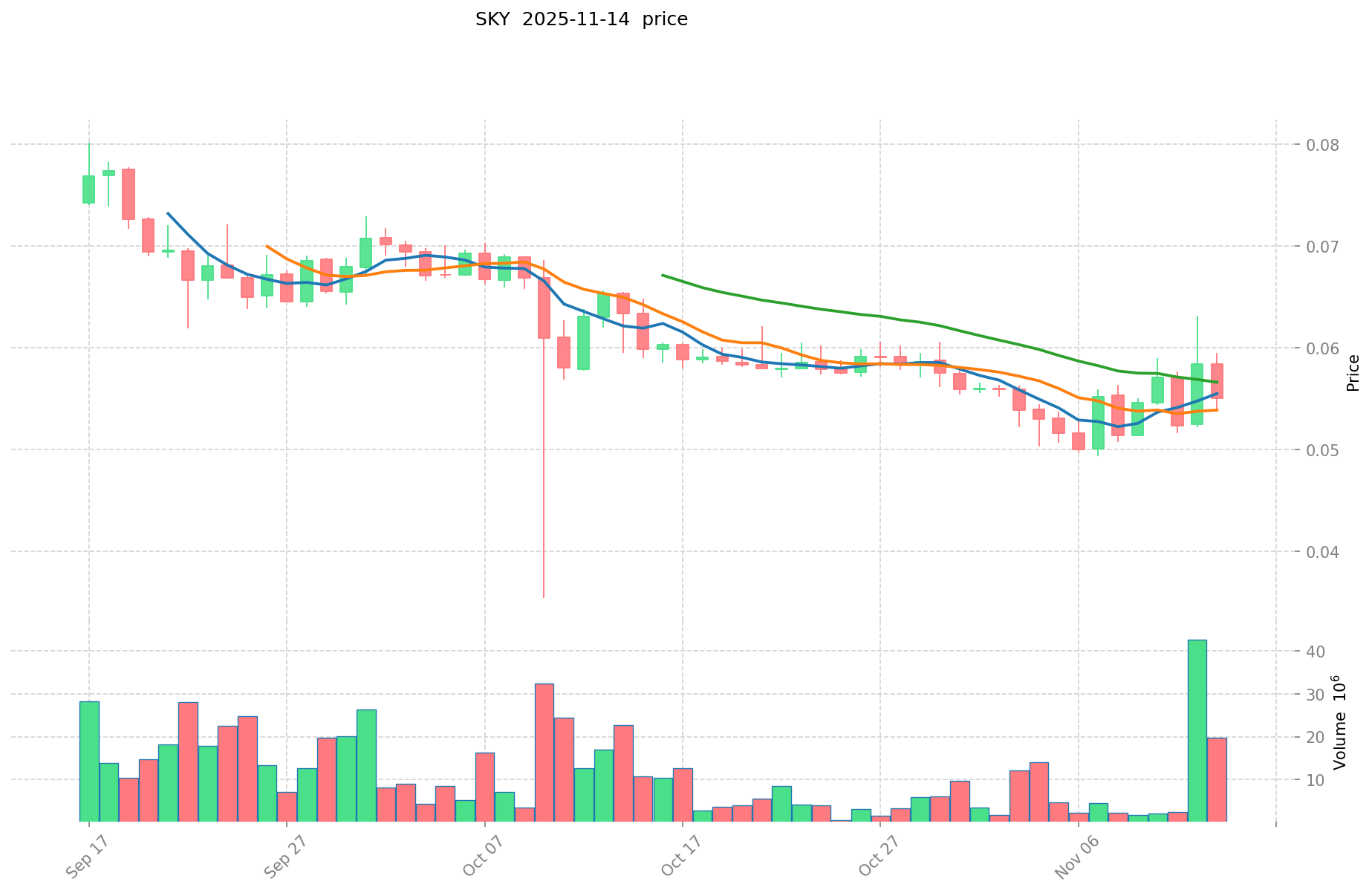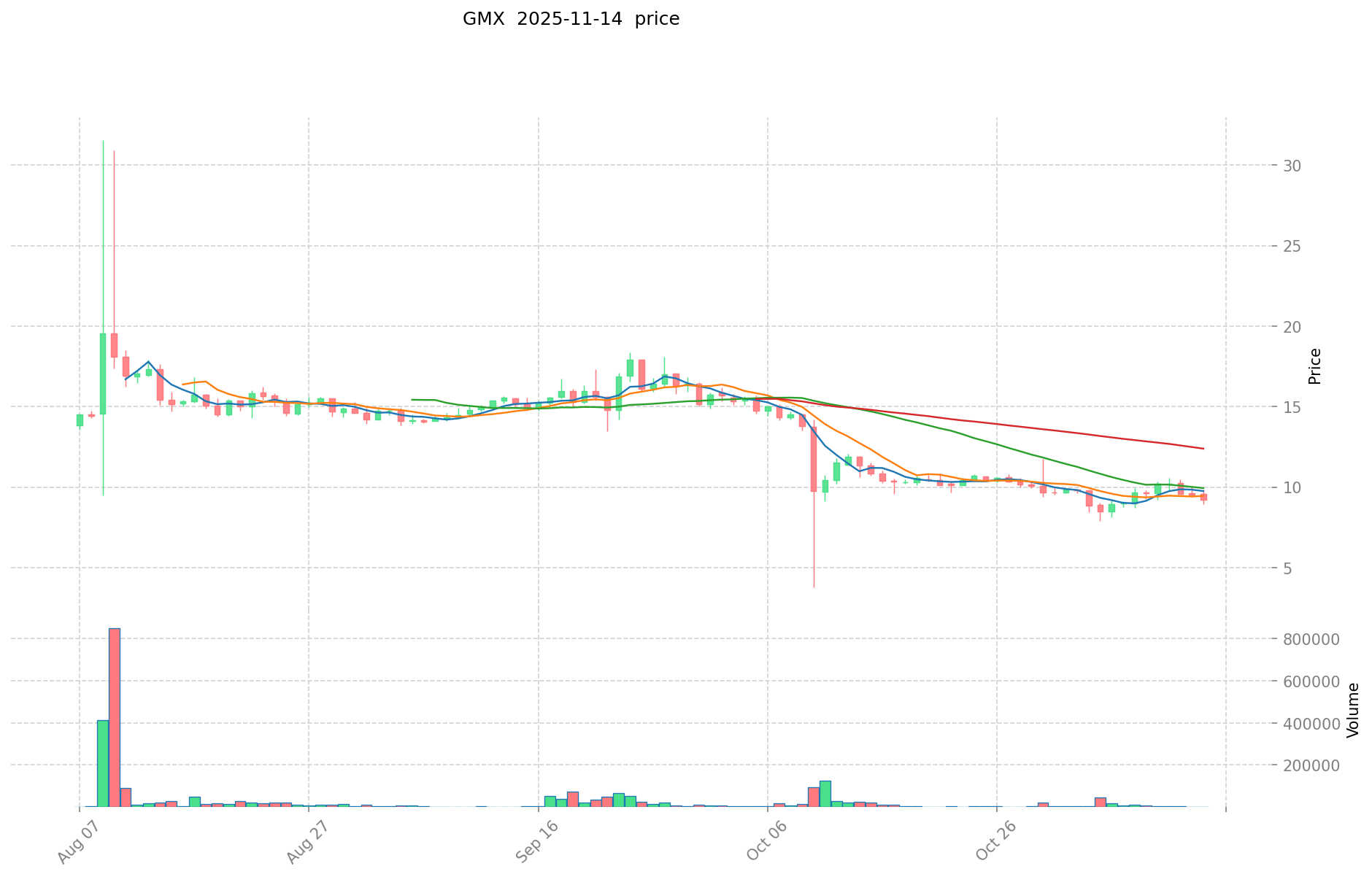SKY vs GMX: Battle of the Cloud Storage Titans - Which Offers Better Security and Value?
Introduction: SKY vs GMX Investment Comparison
In the cryptocurrency market, the comparison between SKY and GMX has always been an unavoidable topic for investors. The two not only show significant differences in market cap ranking, application scenarios, and price performance, but also represent different cryptocurrency asset positions.
SKY (SKY): Since its launch, it has gained market recognition as the governance token of the Sky ecosystem and an upgraded version of the MKR token.
GMX (GMX): Since its inception, it has been hailed as a decentralized and sustainable exchange, with its token serving as both a utility and governance token.
This article will comprehensively analyze the investment value comparison between SKY and GMX, focusing on historical price trends, supply mechanisms, institutional adoption, technological ecosystems, and future predictions, attempting to answer the question investors care about most:
"Which is the better buy right now?"
I. Price History Comparison and Current Market Status
SKY (Coin A) and GMX (Coin B) Historical Price Trends
- 2025: SKY reached its all-time high of $0.08019 on September 17, followed by a significant drop to its all-time low of $0.03538 on October 10.
- 2023: GMX hit its all-time high of $91.07 on April 18, showing strong performance earlier in the year.
- Comparative analysis: In the recent market cycle, SKY has shown high volatility, swinging between $0.08019 and $0.03538 within a short period. GMX, on the other hand, has experienced a more prolonged decline from its peak in 2023 to its current price.
Current Market Situation (2025-11-15)
- SKY current price: $0.05169
- GMX current price: $8.817
- 24-hour trading volume: SKY $784,298.49701 vs GMX $22,056.803597
- Market Sentiment Index (Fear & Greed Index): 16 (Extreme Fear)
Click to view real-time prices:
- View SKY current price Market Price
- View GMX current price Market Price


II. Core Factors Affecting the Investment Value of SKY vs GMX
Supply Mechanism Comparison (Tokenomics)
- SKY: Fixed supply model with a maximum cap of 300 million tokens. The distribution includes 45% allocated to lending markets, 30% to contributors, 15% to the DAO treasury, and 10% for Ozone liquidity.
- GMX: Capped supply of 13.25 million tokens with emissions that decrease over time. The protocol features a deflationary mechanism where 30% of fees are used for GMX buybacks and distribution to stakers.
- 📌 Historical pattern: Fixed supply models like SKY's tend to create scarcity value over time, while GMX's declining emissions and fee-driven buybacks create constant buying pressure that has supported long-term price appreciation.
Institutional Adoption and Market Applications
- Institutional holdings: GMX has attracted more institutional interest due to its longer track record and established profitability, with major funds like Delphi Digital and Mechanism Capital having invested.
- Enterprise adoption: GMX has demonstrated stronger real-world application in the perpetual futures trading market, processing over $120 billion in trading volume since launch, while SKY's lending protocol is still in earlier adoption phases.
- Regulatory attitudes: Both operate in the DeFi space facing similar regulatory scrutiny, though GMX's derivatives focus may attract more regulatory attention in certain jurisdictions compared to SKY's lending platform.
Technical Development and Ecosystem Building
- SKY technical upgrades: The protocol features oracle-free lending with real-time interest rates based on utilization, and an advanced auto-deleveraging system that provides enhanced security for the lending ecosystem.
- GMX technical development: Multi-chain deployment across Arbitrum and Avalanche with a focus on low swap fees and zero price impact trades. The protocol has established real yield mechanisms through ETH/AVAX rewards to token holders.
- Ecosystem comparison: GMX has a more mature ecosystem with established trading volumes and fee generation, while SKY is developing its niche in lending markets with innovative approaches to capital efficiency and risk management.
Macroeconomic Factors and Market Cycles
- Inflation performance: GMX has demonstrated better inflation resistance through its fee-sharing model that ties token value directly to platform usage, generating real yield regardless of market conditions.
- Macroeconomic monetary policy: Rising interest rates typically pressure both tokens, but GMX's trading platform may benefit from increased market volatility during policy shifts.
- Geopolitical factors: Cross-border transaction demand benefits both protocols as DeFi alternatives to traditional finance, with GMX potentially benefiting more during periods of market uncertainty due to increased trading activity.
III. 2025-2030 Price Prediction: SKY vs GMX
Short-term Prediction (2025)
- SKY: Conservative $0.0321-$0.0519 | Optimistic $0.0519-$0.0695
- GMX: Conservative $7.33-$8.83 | Optimistic $8.83-$9.19
Mid-term Prediction (2027)
- SKY may enter a growth phase, with estimated prices of $0.0563-$0.0894
- GMX may enter a consolidation phase, with estimated prices of $7.05-$11.21
- Key drivers: Institutional capital inflow, ETFs, ecosystem development
Long-term Prediction (2030)
- SKY: Base scenario $0.0813-$0.1214 | Optimistic scenario $0.1214-$0.1481
- GMX: Base scenario $11.66-$15.75 | Optimistic scenario $15.75-$20.64
Disclaimer: This analysis is for informational purposes only and should not be considered as financial advice. Cryptocurrency markets are highly volatile and unpredictable. Always conduct your own research before making any investment decisions.
SKY:
| 年份 | 预测最高价 | 预测平均价格 | 预测最低价 | 涨跌幅 |
|---|---|---|---|---|
| 2025 | 0.0695058 | 0.05187 | 0.0321594 | 0 |
| 2026 | 0.080108028 | 0.0606879 | 0.04248153 | 17 |
| 2027 | 0.08940541428 | 0.070397964 | 0.0563183712 | 36 |
| 2028 | 0.1150584323616 | 0.07990168914 | 0.0751075877916 | 54 |
| 2029 | 0.145245290518692 | 0.0974800607508 | 0.083832852245688 | 88 |
| 2030 | 0.14806246427439 | 0.121362675634746 | 0.081312992675279 | 134 |
GMX:
| 年份 | 预测最高价 | 预测平均价格 | 预测最低价 | 涨跌幅 |
|---|---|---|---|---|
| 2025 | 9.18528 | 8.832 | 7.33056 | 0 |
| 2026 | 12.3418368 | 9.00864 | 4.7745792 | 2 |
| 2027 | 11.20900032 | 10.6752384 | 7.045657344 | 21 |
| 2028 | 15.6472306848 | 10.94211936 | 6.8935351968 | 24 |
| 2029 | 18.213704780688 | 13.2946750224 | 7.179124512096 | 50 |
| 2030 | 20.63798877102264 | 15.754189901544 | 11.65810052714256 | 78 |
IV. Investment Strategy Comparison: SKY vs GMX
Long-term vs Short-term Investment Strategy
- SKY: Suitable for investors focused on lending market potential and ecosystem growth
- GMX: Suitable for investors seeking established platforms with real yield and trading volume
Risk Management and Asset Allocation
- Conservative investors: SKY: 30% vs GMX: 70%
- Aggressive investors: SKY: 60% vs GMX: 40%
- Hedging tools: Stablecoin allocation, options, cross-currency portfolios
V. Potential Risk Comparison
Market Risk
- SKY: Higher volatility due to newer platform and smaller market cap
- GMX: Exposure to broader crypto market trends and trading volume fluctuations
Technical Risk
- SKY: Scalability, network stability, and adoption of new lending mechanisms
- GMX: Smart contract vulnerabilities, liquidity risks in extreme market conditions
Regulatory Risk
- Global regulatory policies may impact both, with GMX potentially facing more scrutiny due to its derivatives focus
VI. Conclusion: Which Is the Better Buy?
📌 Investment Value Summary:
- SKY advantages: Innovative lending platform, fixed supply model, potential for high growth
- GMX advantages: Established trading volume, real yield mechanism, multi-chain deployment
✅ Investment Advice:
- New investors: Consider a balanced approach with higher allocation to GMX for its established track record
- Experienced investors: Explore SKY for higher growth potential while maintaining GMX exposure
- Institutional investors: Diversify across both, with GMX for current yield and SKY for future ecosystem growth
⚠️ Risk Warning: The cryptocurrency market is highly volatile. This article does not constitute investment advice. None
VII. FAQ
Q1: What are the key differences between SKY and GMX tokens? A: SKY is the governance token for the Sky ecosystem and an upgraded version of MKR, with a fixed supply of 300 million tokens. GMX is both a utility and governance token for a decentralized exchange, with a capped supply of 13.25 million tokens and a deflationary mechanism.
Q2: Which token has shown better price performance recently? A: GMX has shown more stable performance, while SKY has experienced higher volatility. In 2025, SKY reached an all-time high of $0.08019 but also dropped to an all-time low of $0.03538. GMX hit its all-time high of $91.07 in April 2023.
Q3: How do the supply mechanisms of SKY and GMX compare? A: SKY has a fixed supply model with 300 million tokens, distributed among lending markets, contributors, DAO treasury, and Ozone liquidity. GMX has a capped supply of 13.25 million tokens with decreasing emissions over time and a deflationary mechanism using 30% of fees for buybacks and distribution to stakers.
Q4: Which token has attracted more institutional interest? A: GMX has attracted more institutional interest due to its longer track record and established profitability, with investments from major funds like Delphi Digital and Mechanism Capital.
Q5: What are the main technical features of each token's ecosystem? A: SKY features oracle-free lending with real-time interest rates and an advanced auto-deleveraging system. GMX offers multi-chain deployment, low swap fees, and zero price impact trades, with real yield mechanisms through ETH/AVAX rewards.
Q6: How do the long-term price predictions for SKY and GMX compare? A: By 2030, SKY's base scenario predicts a range of $0.0813-$0.1214, with an optimistic scenario of $0.1214-$0.1481. GMX's base scenario for 2030 is $11.66-$15.75, with an optimistic scenario of $15.75-$20.64.
Q7: What are the main risks associated with investing in SKY and GMX? A: SKY faces higher volatility due to its newer platform and smaller market cap, while GMX is exposed to broader crypto market trends and trading volume fluctuations. Both face technical risks such as smart contract vulnerabilities and regulatory risks, with GMX potentially facing more scrutiny due to its derivatives focus.
Share
Content